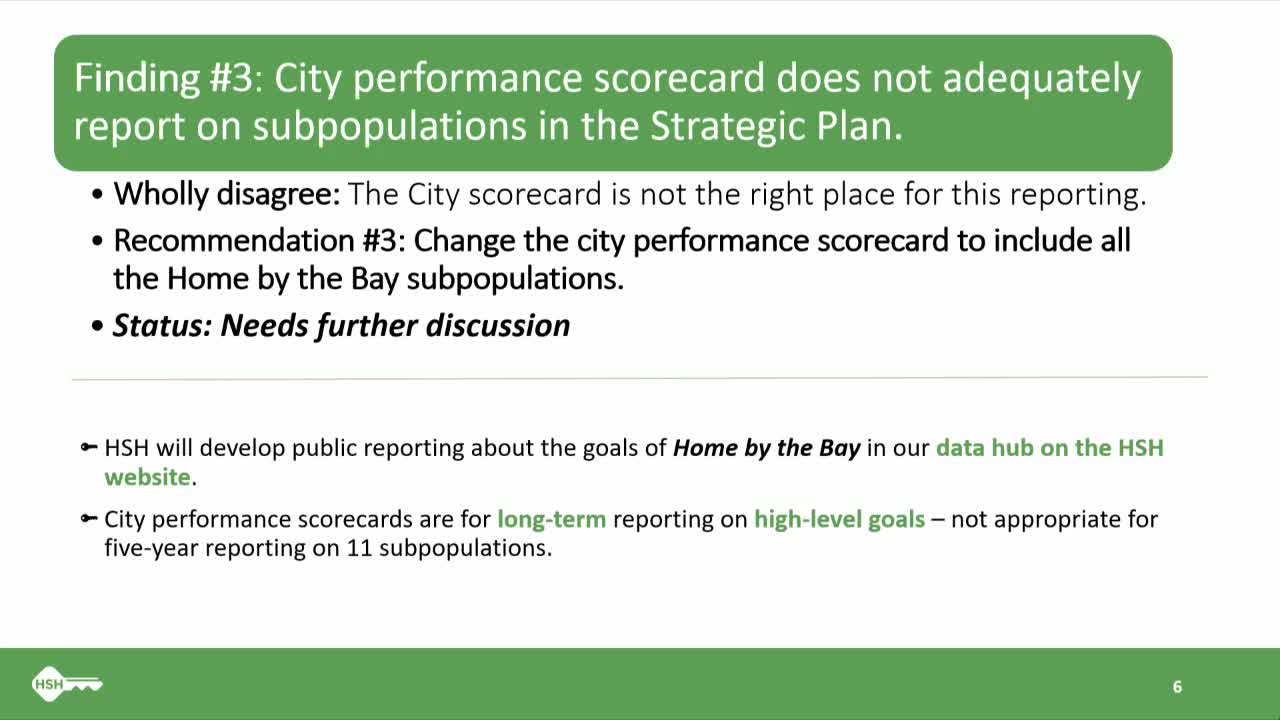San Francisco evaluates metrics for homelessness programs amid ongoing challenges
December 07, 2023 | San Francisco County, California

This article was created by AI summarizing key points discussed. AI makes mistakes, so for full details and context, please refer to the video of the full meeting. Please report any errors so we can fix them. Report an error »

The San Francisco County government meeting on July 4, 2025, focused on critical discussions surrounding homelessness and housing metrics. Officials highlighted the importance of collecting and analyzing data specific to the 11 communities disproportionately affected by homelessness. The meeting emphasized the need for a centralized reporting system on the county's website to track performance metrics aligned with strategic goals.
Key discussions included the implementation of a new policy by the Department of Homelessness and Supportive Housing (HSH) aimed at improving program monitoring. This policy is expected to be fully implemented by the end of the fiscal year 2023-2024. Officials expressed optimism about the ongoing multi-year procurement plan, which aims to enhance service delivery and align metrics with the outcomes that truly matter—such as the long-term stability of individuals placed in housing.
Supervisor Chan noted the impressive retention rates of individuals in supportive housing, with 97% remaining housed in the first year. This statistic underscores the effectiveness of current programs, although there are calls for more comprehensive tracking of eviction rates among different service providers. Concerns were raised about the varying eviction practices and the potential for individuals to become homeless after being displaced from supportive housing.
The meeting also touched on the issue of vacant units in supportive housing, with officials acknowledging the need to streamline the process of filling these units to better serve those in need. The board expressed a commitment to addressing regulatory barriers that delay housing placements, emphasizing the importance of collaboration between the administration and oversight bodies.
Overall, the discussions highlighted a proactive approach to tackling homelessness in San Francisco, with a focus on data-driven strategies and the need for continuous improvement in service delivery. The next steps will involve further evaluation of metrics and collaboration to ensure that the county's efforts effectively address the needs of its most vulnerable populations.
Key discussions included the implementation of a new policy by the Department of Homelessness and Supportive Housing (HSH) aimed at improving program monitoring. This policy is expected to be fully implemented by the end of the fiscal year 2023-2024. Officials expressed optimism about the ongoing multi-year procurement plan, which aims to enhance service delivery and align metrics with the outcomes that truly matter—such as the long-term stability of individuals placed in housing.
Supervisor Chan noted the impressive retention rates of individuals in supportive housing, with 97% remaining housed in the first year. This statistic underscores the effectiveness of current programs, although there are calls for more comprehensive tracking of eviction rates among different service providers. Concerns were raised about the varying eviction practices and the potential for individuals to become homeless after being displaced from supportive housing.
The meeting also touched on the issue of vacant units in supportive housing, with officials acknowledging the need to streamline the process of filling these units to better serve those in need. The board expressed a commitment to addressing regulatory barriers that delay housing placements, emphasizing the importance of collaboration between the administration and oversight bodies.
Overall, the discussions highlighted a proactive approach to tackling homelessness in San Francisco, with a focus on data-driven strategies and the need for continuous improvement in service delivery. The next steps will involve further evaluation of metrics and collaboration to ensure that the county's efforts effectively address the needs of its most vulnerable populations.
View full meeting
This article is based on a recent meeting—watch the full video and explore the complete transcript for deeper insights into the discussion.
View full meeting
